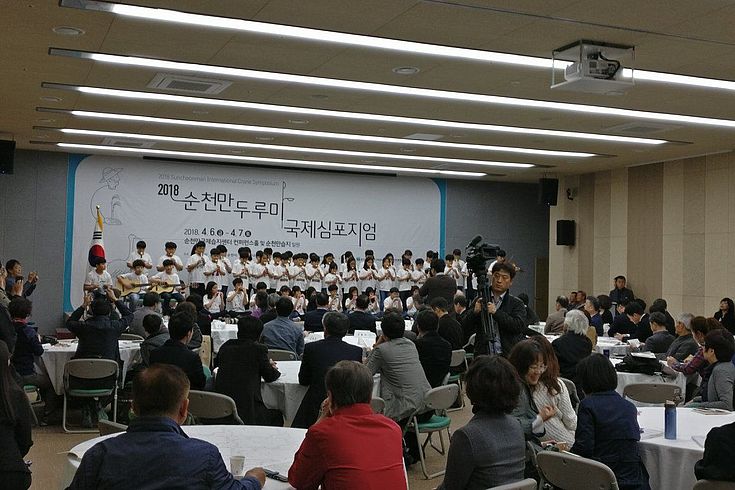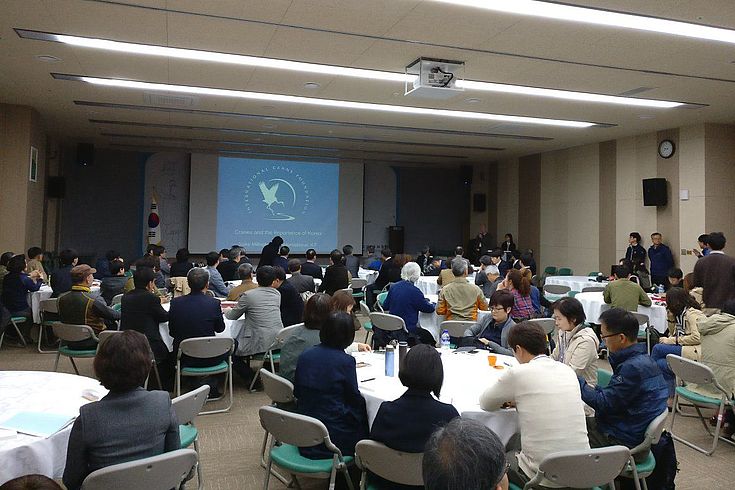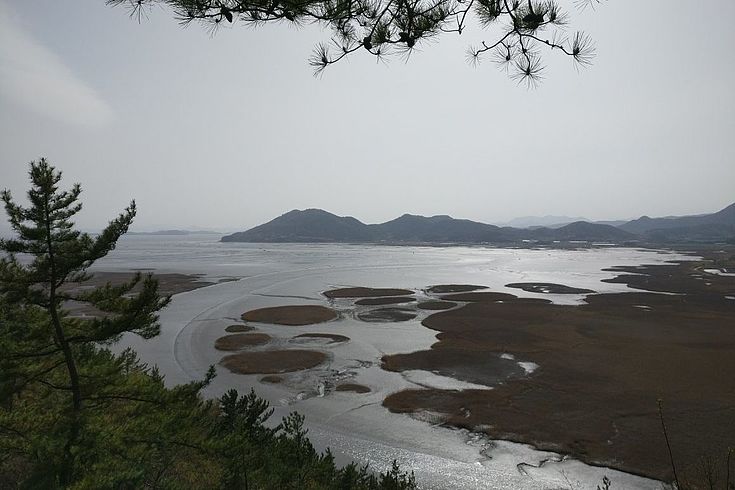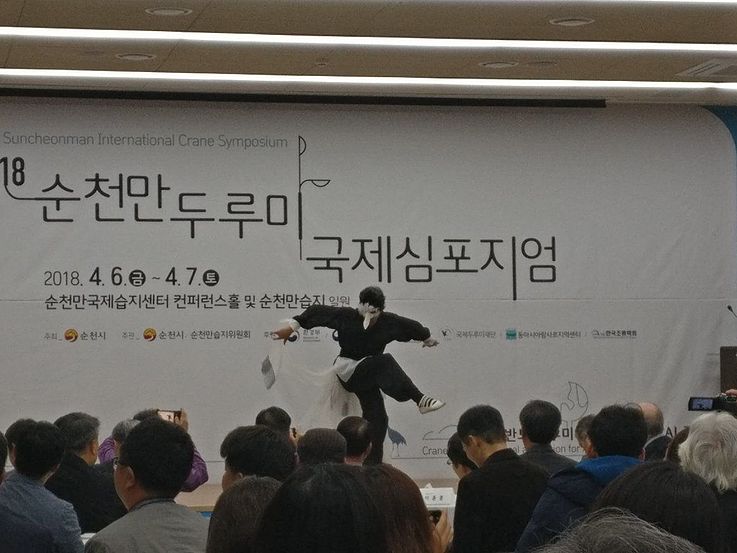International Symposium in Suncheon
Measures For Protecting Endangered Cranes
Cultural performance by school children - raising awareness of the cranes as a cultural asset is an important part of the work of wetland centers.
Cranes have long been symbols of long life and virtue in Korea. Since the division of the Peninsula, cranes - which winter in the South and then fly to their breeding grounds in Northern China, Mongolia and Russia - also symbolize the tragedy of division. In particular, in Cheolwon county at the DMZ, cranes winter on both sides of the border, roosting in the Northern DMZ and feeding in the rice fields in the South. Hanns Seidel Foundation Korea from 2010 to 2014 supported a project on organic farming and crane protection in Anbyon county, North Kangwon province in North Korea. HSF also became member of the East Asian Australasian Flyway Partnership (EAAFP), with a particular focus on efforts for effective biodiversity protection on the Southern and Northern part of the Korean peninsula.
On April 7, 2018, the representative of Hanns Seidel Foundation Korea Dr. Bernhard Seliger, participated in the 2018 Suncheonman International Crane Symposium, which brought together international and national crane specialists. The conference was opened by cultural performances by a children's orchestra and a "crane dance". Cranes and their iconic behavior have long inspired culture. It is important to link these cultural experiences with biodiversity protection today. After the performance, the mayor of Suncheon city, Cheon Yong-jae, opened the conference. Since the 1990's, Suncheon bay gained attention as the wintering area for the Hooded Crane. Also, the head of the Wetland council Park Ky-yong, and the head of the Korean Ornithological Society Paek Un-gy, gave congratulatory remarks. Afterwards, an MoU was signed between the International Crane Foundation represented by Spike Millington, and the cities of Suncheon and Goyang as well as Cheolwon county, for a better protection of wintering cranes.
Presentation on the international status of cranes by Spike Millington of the International Crane Foundation - seven out of fifteen kinds of cranes can be found on the Korean Peninsula, but many of them are endangered.
The scientific part of the conference started with keynote speeches and a session giving an overview of crane populations in Northeast Asia. In particular, the issue of concentration of populations in few places like Suncheon, Cheolwon or Izumi in Japan due to habitat losses in other places, is problematic. Spike Millington of the International Crane Foundation, a long-standing partner of Hanns Seidel Foundation in the Anbyon project, as well as former chief executive of the EAAFP, stressed the link of bird protection and habitat protection. Dr. Lee Ki-sup, head of the Crane Network of Korea, looked at various habitats for cranes in Korea and their destruction, e.g. through the "four river project" in Gumi, where valuable sandbanks disappeared. Kunikazu Momose, Director of the Red-crowned Crane Conservancy, an NGO in Japan, introduced the population of cranes in Hokkaido, which increased from 32 birds in 1952 to over 1800 today, helped by artificial feeding and preservation of habitats. Birds have come to rely on dairy agriculture because of the maintenance of pastures, to an extent where birds are no longer migratory. However, recently dairy farms have decreased, which is a challenge for crane management. Lee Seung-hee of Suncheon city wetland administration reported about the wintering cranes, mainly hooded cranes, at Suncheon bay. Other reports came from Yoo Seung-hwa of the National Institute of Ecology (about Cheolwon), Kim Shin-hwan (Cheonsu bay) and Kim Tae-jwa (Junam reservoir).
The second session dealt with the challenge of Avian influenza (AI) and waterbirds. It has been established without doubt that wild birds are victims of AI, which originates in intensive poultry farming. AI has a tremendous negative influence on the sentiment of people towards migratory birds and often leads to damaging policies like destruction of wetlands, scaring away of birds or large-scale, harmful disinfection. At the same time, the concentration of birds due to the loss of habitat leads to much greater danger to the overall small populations of birds. Makoto Ozawa and Yuko Haraguchi discussed the Japanese experience with AI in Izumi and possible countermeasures. Jheon Weon-hwa and Kim Won-duk discussed AI occurrence in wild birds in Korea. Guo Yumin of Beijing Forestry University and Lee Han-soo looked into AI in China and on the wider flyway. Finally, Park Ky-young of the Suncheonman Wetland Council suggested a bird flu research project.
At the sidelines of the conference, discussions with Spike Millington of International Crane Foundation about future cooperation took place.




